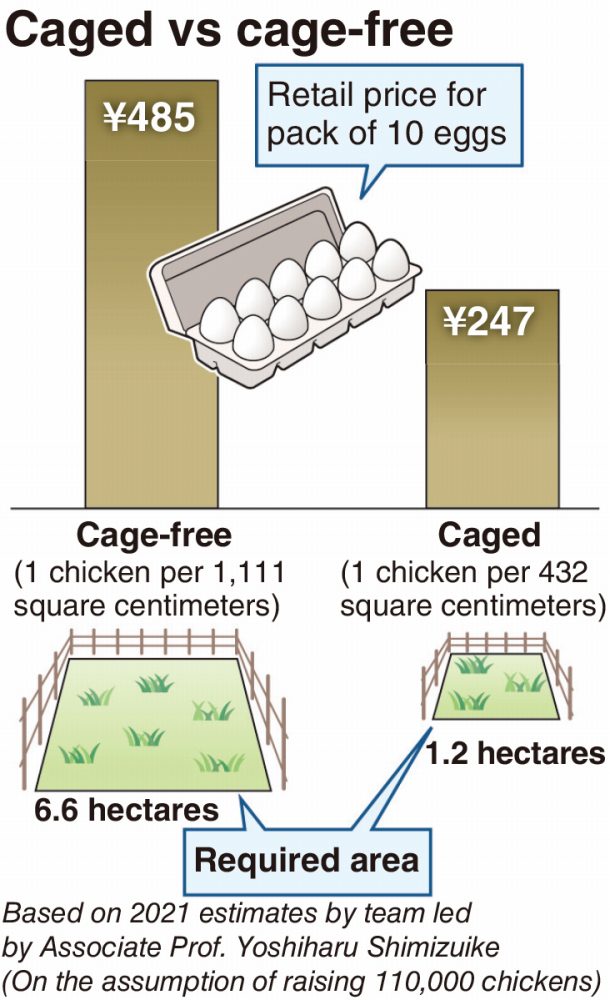
Kurofuji Farm President Yohei Mukoyama in Kai, Yamanashi Prefecture
12:48 JST, September 22, 2023
Poultry farmers in Japan are thinking more about animal welfare, and some are working to raise their chickens in a stress-free environment.
With consumers becoming more aware of where their products are sourced, Japanese businesses are taking steps to procure food from farms that treat their animals humanely. However, the practice could lead to higher egg prices.
Experts are urging the government to get involved to help consumers understand the situation.
Making the switch
Some 1,100 meters above sea level in the mountains of Kai, Yamanashi Prefecture, Kurofuji Farm produces about 60,000 eggs per day. When the chicken coops opened, the hens stepped onto the grass and walked outside.
About 90% of egg farms still raise their chickens in cages. On these farms, one to two chickens are placed in each cage and about two dozen are kept in 1 square meter. Despite it being efficient in terms of production and sanitation, it is stressful for the hens as it restricts their movements.
To create a more comfortable environment, Kurofuji Farm has started rearing its chickens without cages, with its own standards of keeping no more than 4.3 hens per square meter. The firm installed plenty of perches and nests, and the hens are released every morning into a grazing area.
Since 2019, Kurofuji Farm President Yohei Mukoyama has helped 10 farms nationwide make the change.
“Even if sales are lower than for caged ones, we want to show our gratitude to the chickens and make sure they live as stress-free as possible,” Mukoyama said.
Fusion, a farm that raises more than 2 million hens in Miyakonojo, Miyazaki Prefecture, moved 200,000 of them to a cage-free environment in 2018. According to a senior official for the Agriculture, Forestry and Fisheries Ministry, it was an extremely rare move for a large-scale egg farm.
“Animal welfare is a global movement, and we thought we should give it a try,” Fusion President Yasuo Akagi said.
Food manufacturers are also becoming more aware. Kewpie Corp. released a mayonnaise made exclusively using cage-free egg yolks in August. The product is only available online or at department stores.
“We hope to give consumers more options as food culture changes,” a Kewpie spokesperson said.
Leading egg wholesaler JA.Z-Tamago Co. has noticed a steady increase in cage-free eggs.
The change is attributed to the industry’s foresight to expand its sales channels overseas, including in Europe where there is more concern for animal welfare. Ajinomoto Co. has decided not to use eggs from caged chickens in its products sent to Europe.

Too expensive?
Creating cage-free environments for chickens is more expensive, leading to pricier eggs. A team led by Hokkaido University Associate Prof. Yoshiharu Shimizuike estimated that raising 110,000 hens would require 6.6 hectares, which is more than five times the area required for caged chickens. The retail price for a pack of 10 cage-free eggs is nearly twice as much compared to eggs from caged chickens, making it difficult to maintain sales channels.
“After introducing cage-free eggs, we couldn’t even sell half of them for a while. So we ended up having to sell the rest with caged eggs for a lower price,” Akagi said. “We were losing ¥200 million a year.”
There are moves to seek understanding from the public. The Yamanashi prefectural government, for example, established the “Yamanashi Animal Welfare” system last year, which certifies farmers that follow the prefecture’s standards. Nine farms, including egg farms, have received the certification.
Azabu University Prof. Shigeru Oki, who specializes in livestock economics, said: “Despite efforts from individual farms, animal welfare won’t become more widespread if consumers are put off by the price. For the practice to take root, the central government needs to actively work to seek further public understanding, such as by showing more images of the production process of animal products.”
Setting standards
The agriculture ministry in late July created animal welfare guidelines for livestock for the first time and informed each prefecture.
The government’s policy to increase exports of livestock products could be affected by the public’s understanding.
The management guidelines, which are based on the World Organisation for Animal Health standards, are divided into whether the recommended changes need to be implemented immediately or in the future, depending on the animal and other factors. Subsidies are being considered for some cases that would require immediate action.
The guidelines are written in a way that is beneficial to producers, who worry about a decline in productivity. For example, the guidelines do not set a specific measurement for how much space needs to be secured per animal. However, it has drawn criticism from some consumers and researchers who demand strict standards, similar to those set in Europe.
"Society" POPULAR ARTICLE
-

M4.9 Earthquake Hits Tokyo, Neighboring Prefectures
-

Israeli Tourists Refused Accommodation at Hotel in Japan’s Nagano Pref., Prompting Protest by Israeli Embassy and Probe by Prefecture
-

M7.5 Earthquake Hits Northern Japan; Tsunami Waves Observed in Hokkaido, Aomori and Iwate Prefectures
-

Tsukiji Market Urges Tourists to Avoid Visiting in Year-End
-

High School in Kyoto Says Students Shoplifted during Recent School Trip to Bali, Indonesia
JN ACCESS RANKING
-

Tokyo Economic Security Forum to Hold Inaugural Meeting Amid Tense Global Environment
-

Keidanren Chairman Yoshinobu Tsutsui Visits Kashiwazaki-Kariwa Nuclear Power Plant; Inspects New Emergency Safety System
-

Imports of Rare Earths from China Facing Delays, May Be Caused by Deterioration of Japan-China Relations
-

University of Tokyo Professor Discusses Japanese Economic Security in Interview Ahead of Forum
-

Japan Pulls out of Vietnam Nuclear Project, Complicating Hanoi’s Power Plans























